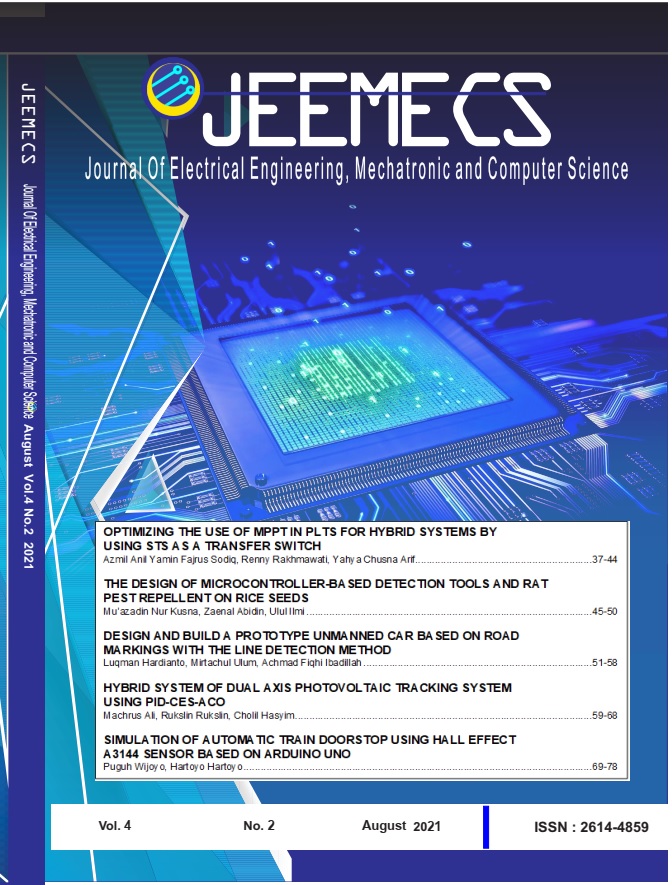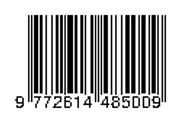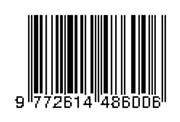HYBRID SYSTEM OF DUAL AXIS PHOTOVOLTAIC TRACKING SYSTEM USING PID-CES-ACO
DOI:
https://doi.org/10.26905/jeemecs.v4i2.6138Keywords:
Ant Colony Optimization, CES, Photovoltaic, Hybrid System,Abstract
In this paper, the efficiency of photovoltaic panels is improved by adding two solar tracking systems. The solar tracking system is used to track the sun so that the photovoltaic always faces the sun. This system uses a dual axis consisting of a horizontal rotation axis and a vertical rotation axis. The motion of the horizontal axis of rotation follows the sun's azimuth angle from north to south. The motion of the vertical axis of rotation following the sun's azimuth angle from east to west is the vertical axis motion. Both types of movement are controlled using PID and Fuzzy controllers which are optimized with an artificial intelligence approach, namely Ant Colony Optimization (ACO). Experiments with PID control approach and CES control were optimized using the ACO method (Hybrid PID-CES-ACO method). Â Â In this research, PID-CES-ACO was the best model, obtained on the horizontal axis of overshot 1328 pu, the smallest undershot was 0.116, and the fastest settling time was 0.183 s, on the vertical axis the smallest overshot was 1.246 pu, the smallest undershot was 0.044, the fastest settling time was 0.163 sDownloads
References
M. Ali, H. Nurohmah, Budiman, J. Suharsono, H. Suyono, and M. A. Muslim, “Optimization on PID and ANFIS Controller on Dual Axis Tracking for Photovoltaic Based on Firefly Algorithm,†in ICEEIE 2019 - International Conference on Electrical, Electronics and Information Engineering: Emerging Innovative Technology for Sustainable Future, 2019, pp. 53–57.
M. Ali, T. Fahmi, D. W. Khaidir, and H. Nurohmah, “Optimizing Single Axis Tracking for Bat Algorithm-based Solar Cell,†J. FESPE, vol. 2, no. 2, pp. 1–5, 2020.
W. Cahyono, M. Ali, and H. Nurohmah, “Ant Colony Optimazation sebagai Tuning PID pada Single Axis Tracking Photovoltaic,†Sinarfe7-2, vol. 2, no. 1, pp. 455–458, 2019.
M. Ali, M. R. Djalal, M. Fakhrurozi, Kadaryono, Budiman, and D. Ajiatmo, “Optimal Design Capacitive Energy Storage (CES) for Load Frequency Control in Micro Hydro Power Plant Using Flower Pollination Algorithm,†in 2018 Electrical Power, Electronics, Communications, Controls and Informatics Seminar, EECCIS 2018, 2018, pp. 21–26.
Kadaryono, Askan, Rukslin, A. Parwanti, M. Ali, and I. Cahyono, “Comparison of LFC optimization on micro-hydro using PID, CES, and SMES based firefly algorithm,†in International Conference on Electrical Engineering, Computer Science and Informatics (EECSI), 2018, vol. 2018–Octob, pp. 204–209.
A. M. S. Yunus and M. Saini, “Overview of SMES units application on smart grid systems,†in Proceeding - 2016 International Seminar on Intelligent Technology and Its Application, ISITIA 2016: Recent Trends in Intelligent Computational Technologies for Sustainable Energy, 2017, pp. 465–470.
M. Ali, Budiman, A. R. Sujatmika, and A. A. Firdaus, “Optimization of controller frequency in wind-turbine based on hybrid PSO-ANFIS,†IOP Conf. Ser. Mater. Sci. Eng., vol. 1034, no. 1, p. 12070, 2021.
M. Arrohman, R. Fajardika, M. Muhlasin, and M. Ali, “Optimasi Frekuensi Kontrol pada Sistem Hybrid Wind-Diesel Menggunakan PID Kontroler Berbasis ACO dan MFA,†J. Rekayasa Mesin, vol. 9, no. 1, pp. 65–68, 2018.
Muhlasin, Budiman, M. Ali, A. Parwanti, A. A. Firdaus, and Iswinarti, “Optimization of Water Level Control Systems Using ANFIS and Fuzzy-PID Model,†in 2020 Third International Conference on Vocational Education and Electrical Engineering (ICVEE), 2020, pp. 1–5.
M. Ali, Muhlasin, H. Nurohmah, A. Raikhani, H. Sopian, and N. Sutantra, “Combined ANFIS method with FA, PSO, and ICA as Steering Control Optimization on Electric Car,†in 2018 Electrical Power, Electronics, Communications, Controls and Informatics Seminar, EECCIS 2018, 2018, pp. 299–304.
M. Ali, F. Hunaini, I. Robandi, and N. Sutantra, “Optimization of active steering control on vehicle with steer by wire system using Imperialist Competitive Algorithm (ICA),†in 2015 3rd International Conference on Information and Communication Technology, ICoICT 2015, 2015, pp. 500–503.
R. Firmansyah, M. Ali, D. Ajiatmo, A. Raikhani, and M. Siswanto, “Optimization of AVR in Micro-hydro Power Plant Using Differential Evolution (DE) Method,†J. FESPE; Front. Energy Syst. Power Eng. Front. Energy Syst. Power Eng., vol. 2, no. 1, pp. 1–6, 2020.
M. Ali, H. Nurohmah, Budiman, H. Suyono, M. A. Muslim, Y. M. Safarudin, and A. A. Firdaus, “Determining firefly ideal parameter for tuning Kp, Ki, And Kd parameter in photovoltaic application,†IOP Conf. Ser. Mater. Sci. Eng., vol. 1034, no. 1, p. 12078, 2021.
M. Dripoyono, Henrdo; Candra, Dwi, Septa; Ajiatmo, Dwi;, Budiman, Budiman; Ali, “Penggunaan ACO dan FA Dalam Mengoptimalkanasikan Kontroler PID Untuk Shading Parsial pada Photovoltaic,†SinarFe7, vol. 1, no. 1, pp. 35–39, 2018.
M. Ali, A. Raikhani, B. Budiman, and H. Sopian, “Algoritma Persaingan Imperialis Sebagai Optimasi Kontroler PID dan ANFIS Pada Mesin Sinkron Magnet Permanen (Imperialist Competitive Algorithm As PID Optimization and ANFIS Controller at Permanent Magnet Synchronous Machine),†JEEE-U (Journal Electr. Electron. Eng., vol. 3, no. 1, p. 57, 2019.
M. Ibrahim, D. Ramadhan, and M. Ali, “Optimasi Kontroler Putaran Motor Permanent Magnet Syschronous Machine ( PMSM ) menggunakan PSO-ANFIS ( Studi Kasus di Perumdam Tirta Kencana ),†Jurna; El-Sains, vol. 2, 2020.
D. Ajiatmo and I. Robandi, “Modeling and simulation performance of photovoltaic system integration battery and supercapacitor paralellization of MPPT prototipe for solar vehicle,†2017, vol. 1818, p. 20076.
D. Ajiatmo and I. Robandi, “A Hybrid fuzzy logic controller-firefly algorithm (FLC-FA) based for MPPT photovoltaic (PV) system in solar car,†in 2016 IEEE International Conference on Power and Renewable Energy, ICPRE 2016, 2017, pp. 606–610.
S. Aksungur and T. Koca, “Solar tracking system with PID control of solar energy panels using servo motor,†Int. J. Energy Appl. Technol., pp. 127–130, 2018.
P. K. B, S. Jonnalagadda, M. Srihari, and H. Bonothu, “DUAL-AXIS SOLAR TRACKER,†Int. J. Recent Sci. Res., vol. 8, no. 2, pp. 15598–15603, 2017.
A. Barbón, J. A. Fernández-Rubiera, L. MartÃnez-Valledor, A. Pérez-Fernández, and L. Bayón, “Design and construction of a solar tracking system for small-scale linear Fresnel reflector with three movements,†Appl. Energy, vol. 285, 2021.
N. Sharma and B. Sharma, “An Analysis of Automatic Dual Axis Sun Tracking Solar System,†Int. J. Innov. Res. Electr. Electron. Instrum. Control Enginering, vol. 4, no. December, pp. 45–47, 2016.
S. Shaher-Soulayman, “Solar Azimuth Angle in the Tropical Zone,†J. Sol. Energy Res. Updat., vol. 4, no. 1, pp. 1–8, 2017.
M. A. Y. Alghifrani, H. Nurohmah, D. Ajiatmo, and M. Ali, “Bat Algorithm Sebagai Optimasi PID Controller Pada Turbin Angin,†Sinarfe7-2, vol. 2, no. 1, pp. 447–451, 2019.
M. Dorigo and T. Stützle, “The Ant Colony Optimization Metaheuristic,†in Ant Colony Optimization, 2018.
Downloads
Additional Files
Published
Issue
Section
License
Our ethic statements are based on COPE’s Best Practice Guidelines for Journal Editors.
Publication decisions
The editor is responsible for deciding which of the articles submitted to the journal should be published.
The editor may be guided by the policies of the journal's editorial board and constrained by such legal requirements as shall then be in force regarding libel, copyright infringement and plagiarism. The editor may confer with other editors or reviewers in making this decision.
Fair play
An editor at any time evaluate manuscripts for their intellectual content without regard to race, gender, sexual orientation, religious belief, ethnic origin, citizenship, or political philosophy of the authors.
Confidentiality
The editor and any editorial staff must not disclose any information about a submitted manuscript to anyone other than the corresponding author, reviewers, potential reviewers, other editorial advisers, and the publisher, as appropriate.
Disclosure and conflicts of interest
Unpublished materials disclosed in a submitted manuscript must not be used in an editor's own research without the express written consent of the author.
Duties of Reviewers
Contribution to Editorial Decisions
Peer review assists the editor in making editorial decisions and through the editorial communications with the author may also assist the author in improving the paper.
Promptness
Any selected referee who feels unqualified to review the research reported in a manuscript or knows that its prompt review will be impossible should notify the editor and excuse himself from the review process.
Confidentiality
Any manuscripts received for review must be treated as confidential documents. They must not be shown to or discussed with others except as authorized by the editor.
Standards of Objectivity
Reviews should be conducted objectively. Personal criticism of the author is inappropriate. Referees should express their views clearly with supporting arguments.
Acknowledgement of Sources
Reviewers should identify relevant published work that has not been cited by the authors. Any statement that an observation, derivation, or argument had been previously reported should be accompanied by the relevant citation. A reviewer should also call to the editor's attention any substantial similarity or overlap between the manuscript under consideration and any other published paper of which they have personal knowledge.
Disclosure and Conflict of Interest
Privileged information or ideas obtained through peer review must be kept confidential and not used for personal advantage. Reviewers should not consider manuscripts in which they have conflicts of interest resulting from competitive, collaborative, or other relationships or connections with any of the authors, companies, or institutions connected to the papers.
Duties of Authors
Reporting standards
Authors of reports of original research should present an accurate account of the work performed as well as an objective discussion of its significance. Underlying data should be represented accurately in the paper. A paper should contain sufficient detail and references to permit others to replicate the work. Fraudulent or knowingly inaccurate statements constitute unethical behavior and are unacceptable.
Originality and Plagiarism
The authors should ensure that they have written entirely original works, and if the authors have used the work and/or words of others that this has been appropriately cited or quoted.
Multiple, Redundant or Concurrent Publication
An author should not in general publish manuscripts describing essentially the same research in more than one journal or primary publication. Submitting the same manuscript to more than one journal concurrently constitutes unethical publishing behaviour and is unacceptable.
Acknowledgement of Sources
Proper acknowledgment of the work of others must always be given. Authors should cite publications that have been influential in determining the nature of the reported work.
Authorship of the Paper
Authorship should be limited to those who have made a significant contribution to the conception, design, execution, or interpretation of the reported study. All those who have made significant contributions should be listed as co-authors. Where there are others who have participated in certain substantive aspects of the research project, they should be acknowledged or listed as contributors.
The corresponding author should ensure that all appropriate co-authors and no inappropriate co-authors are included on the paper, and that all co-authors have seen and approved the final version of the paper and have agreed to its submission for publication.
Disclosure and Conflicts of Interest
All authors should disclose in their manuscript any financial or other substantive conflict of interest that might be construed to influence the results or interpretation of their manuscript. All sources of financial support for the project should be disclosed.
Fundamental errors in published works
When an author discovers a significant error or inaccuracy in his/her own published work, it is the author’s obligation to promptly notify the journal editor or publisher and cooperate with the editor to retract or correct the paper.











